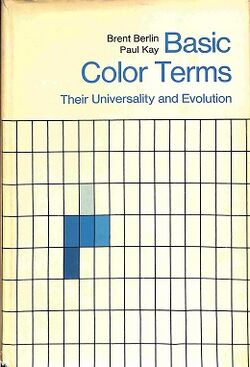Social:Basic Color Terms: Their Universality and Evolution
 | |
| Author | Brent Berlin and Paul Kay |
|---|---|
| Country | Berkeley, California, USA |
| Language | English |
| Genre | Linguistics |
| Publisher | University of California Press |
Publication date | 1969 |
| Media type | |
| Pages | 178 |
| ISBN | 1-57586-162-3 |
| LC Class | P341.B4 |
Basic Color Terms: Their Universality and Evolution (1969) (ISBN 1-57586-162-3) is a book by Brent Berlin and Paul Kay. Berlin and Kay's work proposed that the basic color terms in a culture, such as black, brown, or red, are predictable by the number of color terms the culture has. All cultures have terms for black/dark and white/bright. If a culture has three color terms, the third is red. If a culture has four, it has yellow or green.
Berlin and Kay posit seven levels in which cultures fall, with Stage I languages having only the colors black (dark–cool) and white (light–warm). Languages in Stage VII have eight or more basic color terms. This includes English, which has eleven basic color terms. The authors theorize that as languages evolve, they acquire new basic color terms in a strict chronological sequence; if a basic color term is found in a language, then the colors of all earlier stages should also be present. The sequence is as follows:
- Stage I: Dark-cool and light-warm (this covers a larger set of colors than English "black" and "white".)
- Stage II: Red
- Stage III: Either green or yellow
- Stage IV: Both green and yellow
- Stage V: Blue
- Stage VI: Brown
- Stage VII: Purple, pink, orange, or gray
The work has achieved widespread influence. However, the constraints in color-term ordering have been substantially loosened, both by Berlin and Kay in later publications, and by various critics. Barbara Saunders questioned the methodologies of data collection and the cultural assumptions underpinning the research,[1] as has Stephen C. Levinson.[2]
In 2012, a simple computational model suggested how 'a simple negotiation dynamics, driven by a weak nonlanguage specific bias, namely the frequency dependent resolution power of the human eye, is sufficient to guarantee the emergence of the hierarchy of color names'.[3]
See also
- Linguistic relativity and the color naming debate
- Distinction of blue and green in various languages
- Color blindness
References
- ↑ Saunders, Barbara (2000). "Revisiting basic color terms". Journal of the Royal Anthropological Institute 6:81–99.
- ↑ Levinson, Stephen C. (2000). "Yélî Dnye and the theory of basic color terms". Journal of Linguistic Anthropology 10(1):3–55.
- ↑ "On the origin of the hierarchy of color names". PNAS. April 16, 2012. doi:10.1073/pnas.1113347109. http://cse.iitkgp.ac.in/%7Eanimeshm/hierarchy_evolang.pdf.
Further reading
- Saunders, Barbara and Brakel, J. van (Jaap) (Fall 2002). "The Trajectory of Color". Perspectives on Science, 10(3):302–355.
- Saunders, Barbara A. C. (1992). The Invention of Basic colour terms. Utrecht I.S.O.R.
- Newcomer, Peter and Faris, James (October 1971). "Basic Color Terms". International Journal of American Linguistics, 37(4):270–275.
- Kay, P. and McDaniel, K. (1978). "The Linguistic Significance of the Meanings of Basic Color Terms". Language, 54(3): 610–646.
- Levinson, Stephen C. (2000). "Yélî Dnye and the theory of basic color terms". Journal of Linguistic Anthropology 10(1):3–55.
External links
- "Revisiting Basic Color Terms", by Barbara Saunders. Paper presented to conference on Anthropology and Psychology: The Legacy of the Torres Strait Expedition, St. John’s College, Cambridge 10–12 August 1998.
- Chapter 133: "Number of Basic Colour Categories", by Paul Kay and Luisa Maff, World Atlas for Language Structures Online.
- The World Color Survey by Paul Kay and Richard Cook.
- Chelsea Wald on Why red still means red in Arabic, Swahili, and English

